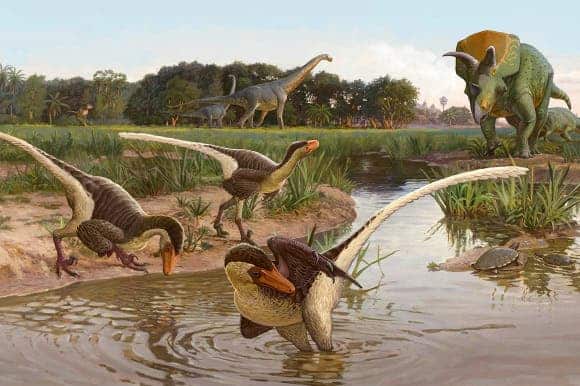A newly-discovered dinosaur species from New Mexico is one of the last raptors to have walked the Earth, researchers report — and they were feathered.
The species, christened Dineobellator notohesperus, lived 67 million years ago in today’s New Mexico, and its discovery helps us better understand life in the region during the last days of the dinosaurs.

Image credits: Sergey Krasovskiy.
The fossils were found in 2008 by Robert Sullivan of the New Mexico Museum of Natural History and Science in Albuquerque, in Cretaceous-aged rocks from the San Juan Basin, New Mexico. Recovery of this initial specimen took four (archeological) field seasons. The name they gave the species means “Navajo warrior from the Southwest,” in honor of the people who today live in the region.
American raptor
Dineobellator is a relative of the Asian (and well-known) species Velociraptor, both part of the dromaeosaurid group — the infamous ‘raptors’. It was, however, much smaller than the raptors you’d see in movies, only being about 3.5 feet (about 1 meter) wide at the hip and 6 to 7 feet (about 2 meters) long.
The team wasn’t able to recover a complete skeleton, but even so, the finding is very exciting. Raptor fossils tend to be pretty rare, as the animals were relatively small and lightly-built predators, and their remains are often destroyed before or during fossilization. “While dromaeosaurids are better known from places like the northern United States, Canada, and Asia, little is known of the group farther south in North America,” says Steven Jasinski, lead author of the study.
Bones from the animal’s forearms show quill nobs, the team explains, which are small surface bumps where feathers would attach to ligaments, making it overwhelmingly likely that Dineobellator sported feathers similar to the Velociraptors. Other features of its skeleton, such as enlarged areas where the claws would attach, suggest that the species would try to latch onto its prey — likely with its smaller forelimbs being used for smaller animals such as birds and lizards, and the feet for larger species such as dinosaur.
The tail also shows some interesting characteristics, the team notes. Most raptors have quite stiff, straight tails, but Dineobellator’s was rather flexible at its base. The authors believe the species used its tail as a rudder of sorts to help preserve balance.
“Think of what happens with a cat’s tail as it is running,” says Jasinski. “While the tail itself remains straight, it is also whipping around constantly as the animal is changing direction. A stiff tail that is highly mobile at its base allows for increased agility and changes in direction, and potentially aided Dineobellator in pursuing prey, especially in more open habitats.”
The team says this find supports the theory that all raptors had feathers, and offers us insight into their hunting behavior.
“It was with a lot of searching and a bit of luck that this dinosaur was found weathering out of a small hillside,” he adds. “We do so much hiking and it is easy to overlook something or simply walk on the wrong side of a hill and miss something. We hope that the more we search, the better chance we have of finding more of Dineobellator or the other dinosaurs it lived alongside.”
The paper “New Dromaeosaurid Dinosaur (Theropoda, Dromaeosauridae) from New Mexico and Biodiversity of Dromaeosaurids at the end of the Cretaceous” has been published in the journal Scientific Reports.









